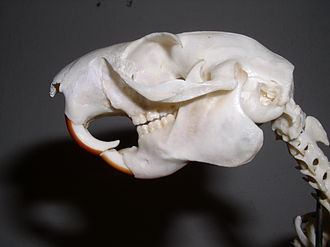Sciuromorpha

Sciuromorpha is an order of rodents that includes squirrels, chipmunks, marmots, woodchucks, and prairie dogs among others. This group is characterized by their similar skull structures and dental patterns, particularly the shape of the zygomatic plate. The name "Sciuromorpha" derives from Greek, with "sciurus" meaning squirrel and "morphē" meaning form or shape, indicating the squirrel-like appearance of these animals.
Characteristics[edit]
Sciuromorpha species exhibit a wide range of sizes, from small chipmunks to the much larger marmots. Despite their size differences, they share common characteristics such as strong, robust bodies; large, sharp incisors that grow continuously; and powerful hind legs that are adapted for jumping and climbing. Their tails can be bushy or relatively slender, depending on the species, and are often used for balance and communication.
Habitat and Distribution[edit]
Members of the Sciuromorpha order can be found in a variety of habitats, including forests, grasslands, mountains, and deserts across the globe. They are primarily distributed in the Northern Hemisphere, with the highest diversity in North America and Eurasia. These animals are adaptable and can live in close proximity to human settlements, often becoming common sights in parks and backyards.
Diet[edit]
The diet of Sciuromorpha rodents is varied and includes seeds, nuts, fruits, insects, and occasionally small vertebrates. Some species, like the gray squirrel, are known for their habit of storing food in caches to survive the winter months. This behavior is crucial for their survival in colder climates where food becomes scarce during winter.
Reproduction[edit]
Sciuromorpha rodents typically have one or two litters per year, with the number of offspring varying by species. They are known for their relatively short gestation periods and the care they provide to their young, which are born blind and helpless. The young are weaned after a few weeks and become independent after a few months.
Conservation Status[edit]
The conservation status of Sciuromorpha species varies widely. While some species, like the common squirrel, are abundant and face no immediate threats, others are endangered due to habitat loss, hunting, and other human activities. Conservation efforts are in place for several species to protect their habitats and ensure their survival.
Classification[edit]
The order Sciuromorpha is part of the class Mammalia and includes several families, the most well-known of which is the Sciuridae (squirrels). Other families within this order have been subject to debate and reclassification over the years, reflecting the ongoing research and discoveries in mammalian taxonomy.

Ad. Transform your life with W8MD's Budget GLP-1 injections from $75


W8MD offers a medical weight loss program to lose weight in Philadelphia. Our physician-supervised medical weight loss provides:
- Weight loss injections in NYC (generic and brand names):
- Zepbound / Mounjaro, Wegovy / Ozempic, Saxenda
- Most insurances accepted or discounted self-pay rates. We will obtain insurance prior authorizations if needed.
- Generic GLP1 weight loss injections from $75 for the starting dose.
- Also offer prescription weight loss medications including Phentermine, Qsymia, Diethylpropion, Contrave etc.
NYC weight loss doctor appointmentsNYC weight loss doctor appointments
Start your NYC weight loss journey today at our NYC medical weight loss and Philadelphia medical weight loss clinics.
- Call 718-946-5500 to lose weight in NYC or for medical weight loss in Philadelphia 215-676-2334.
- Tags:NYC medical weight loss, Philadelphia lose weight Zepbound NYC, Budget GLP1 weight loss injections, Wegovy Philadelphia, Wegovy NYC, Philadelphia medical weight loss, Brookly weight loss and Wegovy NYC
|
WikiMD's Wellness Encyclopedia |
| Let Food Be Thy Medicine Medicine Thy Food - Hippocrates |
Medical Disclaimer: WikiMD is not a substitute for professional medical advice. The information on WikiMD is provided as an information resource only, may be incorrect, outdated or misleading, and is not to be used or relied on for any diagnostic or treatment purposes. Please consult your health care provider before making any healthcare decisions or for guidance about a specific medical condition. WikiMD expressly disclaims responsibility, and shall have no liability, for any damages, loss, injury, or liability whatsoever suffered as a result of your reliance on the information contained in this site. By visiting this site you agree to the foregoing terms and conditions, which may from time to time be changed or supplemented by WikiMD. If you do not agree to the foregoing terms and conditions, you should not enter or use this site. See full disclaimer.
Credits:Most images are courtesy of Wikimedia commons, and templates, categories Wikipedia, licensed under CC BY SA or similar.
Translate this page: - East Asian
中文,
日本,
한국어,
South Asian
हिन्दी,
தமிழ்,
తెలుగు,
Urdu,
ಕನ್ನಡ,
Southeast Asian
Indonesian,
Vietnamese,
Thai,
မြန်မာဘာသာ,
বাংলা
European
español,
Deutsch,
français,
Greek,
português do Brasil,
polski,
română,
русский,
Nederlands,
norsk,
svenska,
suomi,
Italian
Middle Eastern & African
عربى,
Turkish,
Persian,
Hebrew,
Afrikaans,
isiZulu,
Kiswahili,
Other
Bulgarian,
Hungarian,
Czech,
Swedish,
മലയാളം,
मराठी,
ਪੰਜਾਬੀ,
ગુજરાતી,
Portuguese,
Ukrainian